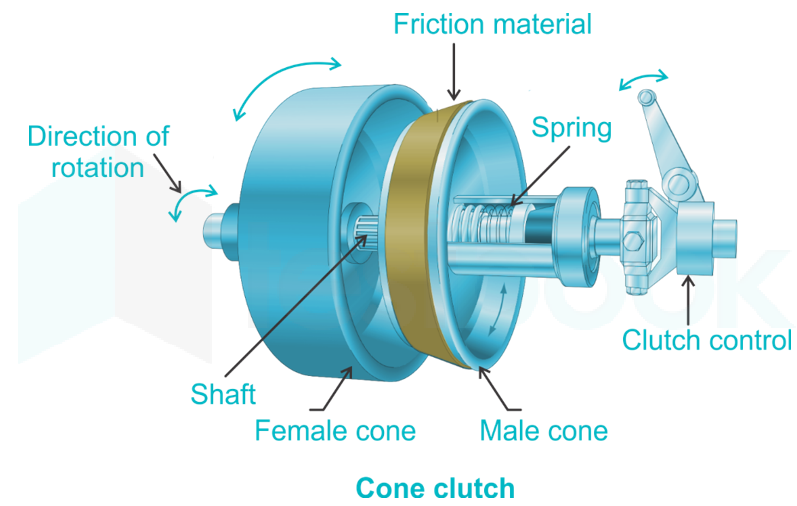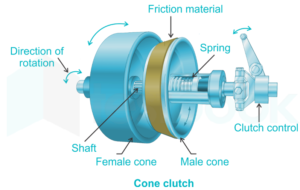What Is Cone Clutch?
A cone clutch serves the same purpose as a disk or plate clutch. However, instead of mating two spinning disks, the cone clutch uses two conical surfaces to transmit torque by friction.
The cone clutch is an axially actuated clutch that, for its size, can transmit a relatively high torque compared to a single-disc plate clutch of the same dimensions. This results from the wedge effect and the increased friction surface. Cone clutches are not now widely used and are generally used for low peripheral speed applications.
Parts Of Cone Clutch
- Cones: female cone (green), male cone (blue)
- Shaft: male cone is sliding on the splines.
- Friction material: usually on female cone, here on male cone.
- Spring: brings the male cone back after using the clutch control.
- Clutch control: separating both cones by pressing.

-
1. Cone
In cone clutch there is two types of cone, female cone (green), male cone (blue)
- Female Cone. It is the part of a cone that is connected to the flywheel of the engine and also rotates with it. This cone has an inner cutting cone-shaped groove through which the outer cone meshes and thus comes into frictional contact in order to engage the drive.
- Male Cone. It is the part of a cone clutch that is connected to the transmission shaft and is machined in the shape of a solid cone, over which friction material is attached. When the clutch pedal is released, the outer cone comes into contact with the inner cone due to the spring action of the released spring behind it and the drive takes place.
2. Shafts
The inner cone, which is attached directly to the flywheel, is mounted over a solid shaft. The outer cone, however, is mounted over the spline shaft.
3. Springs
Behind the outer cone, there are springs that serve to keep the inner cone in engagement with the outer cone. When the clutch pedal is disengaged, the spring is compressed and the inner cone separates from the outer cone, thus disconnect the driving shaft from the driven shaft.
4.Sleeves.
Sleeves are the part of the clutch which is attached to the male cone and mounted on the splines and these sleeves are used for the motion of the male cone.
5. Pedal
A clutch pedal is used to operate the clutch. When the clutch pedal is pressed, the spring is compressed through the fulcrum attached at its other end.
6. Flywheel
It is the part of the engine used to store the engine output it can be considered the part of a clutch system as the female cone of the cone clutch is attached to the flywheel and rotates with it.
Advantages Of Cone Clutch
- It creates less noise than plate clutch.
- Less wear and tear as compared to displacement clutch.
- A small axial force is required to keep the clutch engaged.
- Simple design.
- Higher torque can be transferred than the same size of plate clutch due to large amount of frictional force involved.
Disadvantages Of Cone Clutch
- A high level of maintenance is required, as very little wear can cause a significant part of the axial movement of the inner cone.
- Disengaging becomes very difficult if the cone angle is smaller than required. The cone angle should be exactly as desired for easy disengagement.
Applications Of Cone Clutch
- Cone clutch is used in low peripheral speed applications.
- Cone clutch is common in automobiles and other combustion engine transmissions.
- It is also used in very specialist transmissions in racing, rallying, or in extreme off-road vehicles.
- Cone clutches are used in power boats.
- Small cone clutches are used in synchronizer mechanisms in manual transmissions



[…] Cone Clutch: Definition, Parts, Working And Uses […]
[…] Cone Clutch: Definition, Parts, Working And Uses […]